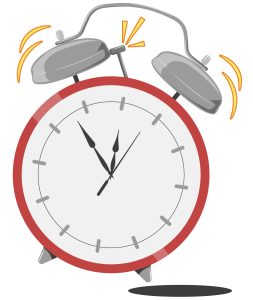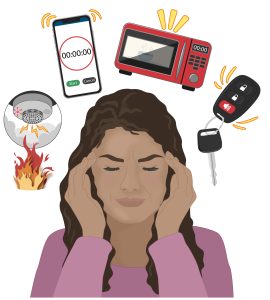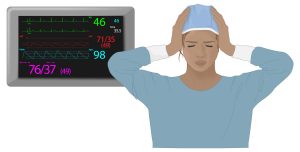Are you alarmed at the alarming array of alarms? We admit, this is a bit cheeky, but we are surrounded by a dizzying, if not downright baffling, flood of audible alarm alerts that can understandably cause alarm fatigue in nurse anesthetists.
Do you ever get tired of or annoyed at an alarm? Has this led you to mute and then disable an alarm? How did we get to where we are today? Let’s take a glimpse at our “state of alarms.”
| Table of Contents
- A Look Back at the Evolution of the Alarm’s Ubiquity
- The Incessant Nature of an Alarm: The Pulse Oximeter (POX)
- What is Alarm Fatigue?
- Alarms Alarming at an Alarming Rate
- Failure-to-Rescue: Alarm Fatigue Impacts on Patient Safety
- Alarming Alarm Issues! Three Representative Case
- Complexity Rules!
- How Can We Do Better, and What is the Future of Patient Alarm Systems?
- Final Note on Alarm Fatigue
A look back at the evolution of the alarm’s ubiquity
Audible alarms are ubiquitous in domains where physiological parameters are assessed, such as the hospital ward, ICU, PACU, and the OR. Their use likely originated with the ‘cardiotachoscope,’ as clinicians first referred to it in the early 1950s. This predecessor to our contemporary devices was a cathode ray tube offering a flat panel display of the heart’s electrical activity. It could also alert clinicians to rates deemed too high or too low. The first continuous, real-time physiological information became quite the sensation!
However, among the earliest “threshold” alarms was one developed after the horrific London fire of 1666. This system consisted of a string tautly woven through the upper rooms of a house, ending on the lowest floor, a hard object tied to its end. A foot below the weight was a metal pan serving as a ‘gong.’ Theoretically, a fire would lyse the string, causing the object to strike the ‘gong,’ alerting the occupants. Some believed this led to the origin of “better late than never.”
We can think of an alarm as a sound emerging from a monitor that alerts us to something. Outside our work environment, alarms are everywhere. You fail to buckle up, and your car emits an unpleasant ding or beep. A clock may rouse you from a night’s slumber. Let’s not overlook the menacing shrill of a home smoke detector or that of the hospital code beeper.

Common to each is that they notify us rapidly and consistently of a condition that merits our attention. In doing so, They arm us with information that guides an appropriate intervention. That might be removing a dish from the microwave, buckling up, or checking the functionality of our breathing circuit.
The incessant nature of an alarm: The Pulse Oximeter (POX)
Our POX is a monitoring standard providing real-time physiological information. Walk through a typical ICU, and a cacophony of beeps, dings, bells, chimes, whistles, and shrills will likely greet you. All those sounds alert the clinician to an actual or evolving time-sensitive concern.
What is alarm fatigue?
You Know It When You Feel It! Alarm fatigue is a desensitization phenomenon occurring when CRNAs are exposed to several or more frequent alarms or alerts. Some describe it as a sensory overload resulting from excessive alarm activation. What may result is a slower response to, or even ignoring, an alarm.
The Joint Commission (JC)yearly establishes National Patient Safety Goals (NPSG). The recent NPSG Goal 6 states: “Improve the safety of clinical alarm systems. Such systems are intended to alert clinicians to potential patient problems, but if they are not properly managed, they can compromise patient safety.” The rationale offered by the JC notes that the problem is global, discriminating among signals is difficult, and the overall noise can produce alarm fatigue.
Alarms alarming at an alarming rate
Let’s take a closer look at what might be causing alarm fatigue.
Studies by the Agency for Healthcare Quality and Research demonstrate that 80-99% of electrocardiogram(ECG) alerts are false or insignificant.
This alone suggests a need for our attention, but wait, there’s more!
We’ve come a long way since the cardiotachoscope. Electronic displays of common and not-so-common parameters are the rule rather than the exception, and most are wedded to an alarm. But at what cost? Research reveals it may be a sword cutting both ways as alarms often burden clinicians with too many, often inconsequential, notifications.
Like the JC recommendations, The Association for the Advancement of Medical Instrumentation, whose goals are to improve the efficacy and safety of devices, reports that over 90% of monitor alerts are non-actionable. Clinicians, CRNAs included, are alerted too often, which may result in alarm fatigue, making us desensitized to truly actionable alerts.

The scope of the problem is substantial. One of several multi-institutional reports published by the JC reveals that 80 patients died, and 13 suffered severe injury because of alarm misadventures. These included improperly set alarms and ones ignored due to alarm fatigue. The JC opined these findings underrepresent the scope of the problem.
In today’s marketplace, healthier patients are increasingly managed on an ambulatory basis, such that those hospitalized are usually older with comorbidities. Such patients may be particularly vulnerable to alarm misadventures as frontline personnel may not get involved until significant decompensation occurs.
Failure-to-rescue: alarm fatigue impacts on patient safety
Patient monitoring technology is often characterized by highly sensitive but nonspecific alerts, resulting in alarm fatigue and low actionability by providers. The phenomenon of failure-to-rescue(FTR) is the failure or delay in recognizing and responding to a patient experiencing complications from a disease process or medical intervention. The worst iteration is one of a poor outcome, even death.
In the increasingly challenging environment we all work in, FTR incidents have increased, not decreased, urging a rethinking of how we traditionally monitor patients and alert clinicians<.
Alarming alarm issues! Three representative cases
In a study referred to by the JC, researchers observed hundreds of patients. They focused on any monitoring-related issues. One patient in the study followed for 17 days generated an average of 1,100 alerts every single day! The alarms were almost always false, caused by movement, electrode detachment, agitation, a family member touching a sensor, or were not clinically actionable. However, 3 were due to serious cardiac events that required intervention.
Another case involved the death of a teen following a tonsillectomy in a Pennsylvania ambulatory center. The provider intentionally disabled the respiratory monitoring device due to its repeated alarming. This tragedy resulted in a $6 million malpractice settlement.
Finally, a third case type of alarm fatigue is experienced by the patients themselves—non-actionable alarms hampering a patient’s recovery, especially common in the ICU. While sleep is vital in recovering from illness and surgical trauma, the often-incessant cacophony of alarms can greatly erode sleep quality.
We cannot simply ignore alarms. Think of it as the N-of-1 problem. Even if 999 times out of 1000 the alert is bogus or clinically insignificant, it’s the 1 out of 1000 that makes that alert indispensable.
Complexity rules!
The complexity of the critical care environment is characterized by multiple monitoring devices in simultaneous use, each with an associated alarm that isn’t prioritized over or coordinated with other devices. CRNAs, especially during the COVID-19 pandemic, increasingly cared for patients outside the OR, primarily in ICUs. They emerged as an institutional resource with keen critical care skills and contributed substantially to meeting the challenges of one of our greatest public health crises.
One CRNA we spoke with led us to a study reported by the JC that found ICU clinicians might routinely deal with an average of well over 100 monitoring device alarms in a single 8-hour shift. Her experience during the pandemic mirrored this finding. We rely heavily on threshold alarms such as our SpO, HR, RR, etCO2, BP, BIS, and a host of others in a manner not unlike the “string-fire-alert” of 1666. Yet clinical trials and authoritative systematic reviews reveal considerable flaws in their design and use.
How can we do better, and what is the future of patient alarm systems?
Issues related to monitors and alarms represent major care and safety concerns. While we’ve appreciated these for a long time, the COVID-19 crisis amplified, illuminated, and may have accelerated the search for practical solutions. We have fixes with more on the way.
For example, the American Association of Critical-Care Nurses (AACN) established a practice alert outlining evidence-based recommendations to mitigate alarm fatigue and false alarms.
At the institutional leadership level:
- Create an interdisciplinary alarm management team.
- Develop guidelines for monitoring only those with clinical indications for monitoring.
- Customize unit-specific default parameters and alarms.
- Provide staff education on monitoring systems and alarms.
At the point-of-care clinician level:
- Meticulous application of monitors (e.g., electrodes, POX).
- Customize alarm settings for each patient and review them daily.
- Check the functionality of the alarm systems at regular intervals.
- Adjust monitors and alarm settings based on a patient’s events.
Artificial intelligence is playing a bigger role, with more to come
There are corporate and academic enterprises pursuing the use of artificial intelligence (AI) in patient monitoring and alarm domains. The goals are to decrease erroneous alerts, prioritize those deemed most critical, and provide decision support in response to an alert. Reducing non-actionable alarms is important for enhancing the clinical work environment and optimizing care.
Final note on alarm fatigue in CRNAs
Akin to the parable of the boy who cried wolf, there is a risk that the sometimes incessant and uncoordinated cacophony of alarms may lead to desensitization or impairment in an appropriately linked response. There may even be muting or disarming of an important alert by the clinician.
CRNAs on the front lines of patient care recognize the challenges associated with monitoring system alerts. There is every reason to be optimistic that positive changes in this important safety domain are coming.
Need CPC Core Modules or Class A credits? Sign up at www.apexanesthesia.com/crna.








